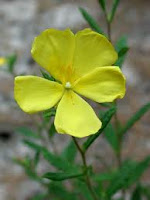EUROPEAN ROCK ROSE, CISTUS (INCANA) CRETICUS
The European rock rose is a native of the Mediterranean and grows profusely on the Greek island of Crete
 The plant is also known as Gum Cistus and Balm of Gilead, although it is not the oil of the ancient persimmon tree. Some, however, say that it is the oleo-resin from this plant that was the Biblical Balm of Gilead. Whatever the case, the resinous substance from the European rock rose has been used since antiquity as incense and for medicinal purposes, along with myrrh and frankincense. It has also been used to purify the air as well as used in religious ceremonies.
The plant is also known as Gum Cistus and Balm of Gilead, although it is not the oil of the ancient persimmon tree. Some, however, say that it is the oleo-resin from this plant that was the Biblical Balm of Gilead. Whatever the case, the resinous substance from the European rock rose has been used since antiquity as incense and for medicinal purposes, along with myrrh and frankincense. It has also been used to purify the air as well as used in religious ceremonies. It was one of 16 other ingredients in Kyphi, an incense preparation used by the ancient Egyptians, for religious and medicinal reasons, according to Plutarch, who also says that it was used as “a potion and salve”. It is also part of Neriko, an ancient Japanese incense blend which has been in use since the 7th century.
This oleo-resin from the European rock rose is called Ladanum or labdanum (not laudanum which was an opium based tincture). It was much-[prized in the ancient world and was gathered in a rather strange way. Goats were taken to graze where the European rock roses grew, and the oleo-resin would stick to their long hair and beards. They would be shorn and the hair boiled in water, as the resin in non-soluble in water, so as it rose to the top, it would be skimmed off. There are some who still gather it in this way on the island of Crete
 This rock rose even figures in some of the Minoan frescoes found on
This rock rose even figures in some of the Minoan frescoes found on This oleo resin comes from the glandular hairs on the leaves of the plant, and is viewed as an acceptable alternative to ambergris which is no longer legally obtainable in viable amounts for the perfume and cosmetics industry. The mauve-flowered plant produces the most labdanum of all and this is at its peak for harvesting purposes in the hot summer months.
 The resin is used for its antibiotic effects and the leaves and resin are used as an expectorant, in cases of catarrh and for diarrhoea, and for regulating the menstrual flow. Just one cup a day of rock rose leaf tisane is said to boost the immune system and protect the cardio-vascular system. This no doubt is due to its potent antioxidant properties- said to be more than those of green tea.
The resin is used for its antibiotic effects and the leaves and resin are used as an expectorant, in cases of catarrh and for diarrhoea, and for regulating the menstrual flow. Just one cup a day of rock rose leaf tisane is said to boost the immune system and protect the cardio-vascular system. This no doubt is due to its potent antioxidant properties- said to be more than those of green tea. The balsamic nature of the resin makes it a good wound healer, and the crushed fresh leaves may be placed on wounds to heal them and clean them. Labdanum is good for skin problems and it also has antimicrobial and antifungicidal properties.



















































